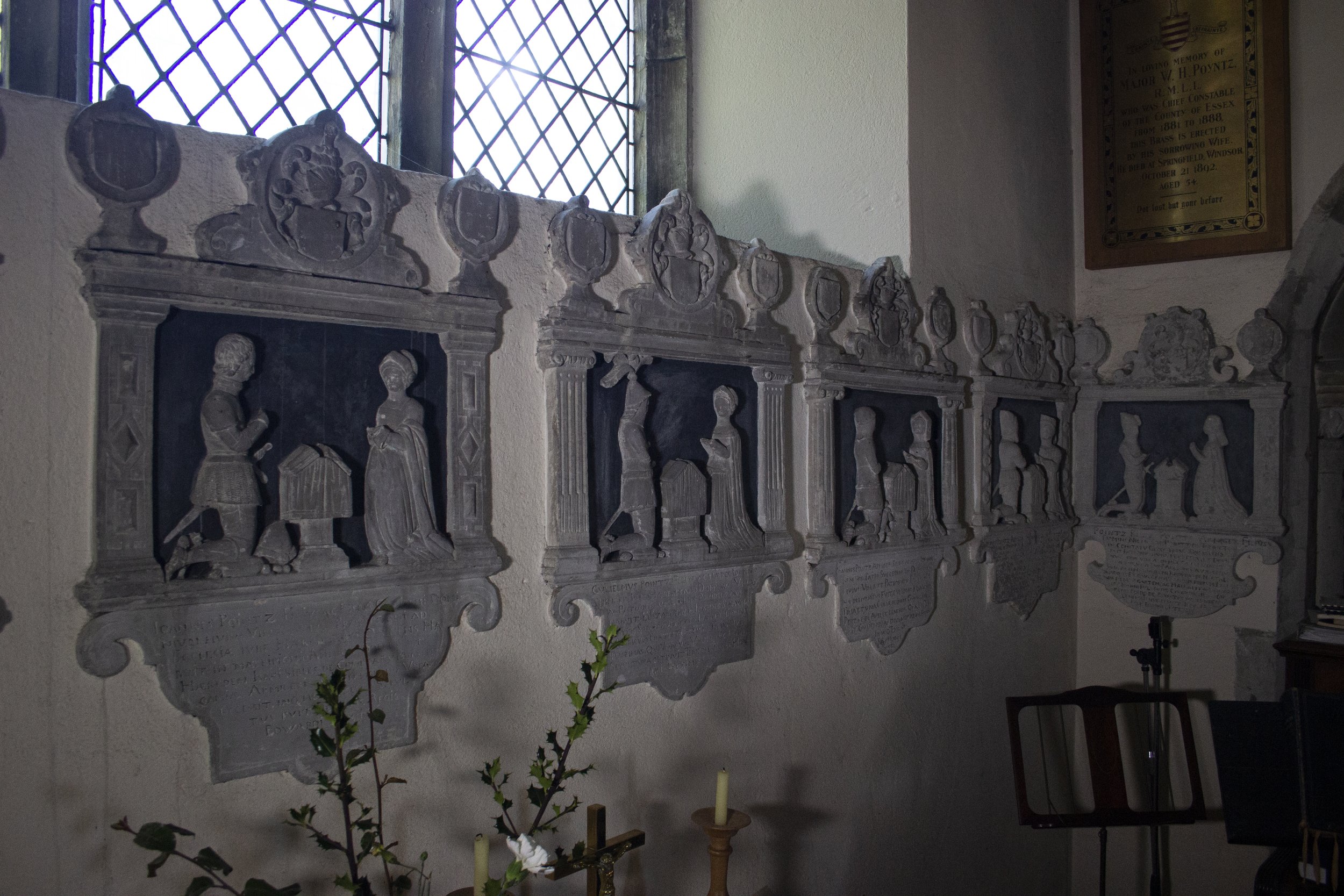Poyntz for Posterity
A recent return to possibly the most idyllic church, that is roughly 23 miles from Central London, with St Mary Magdalene in North Ockendon which is situated just on the cusp of the London Borough of Havering and South Essex border with Thurrock. The church has ancient origins and is undoubtedly one of the best kept ecclesiastical buildings I’ve had the pleasure of visiting, which is marvellous considering its obscure remoteness on the rural city outskirts. However, it is within this particularly church where lies a most fine and important collection of monuments all commemorating a once prominent family here in North Ockendon.
Drawing of the Poyntz Chapel (1825) taken from the article Essex Journal: North Ockendon - St Mary Magdalene by Rev. E. F. Evans (1928)
A view of the Poyntz Chapel in 2025
The Poyntz Chapel was originally a 14th century addition within which are commemorated generations of the local Poyntz family who once resided at the adjacent North Ockendon Hall which was unfortunately destroyed in WW2. It’s a quite an experience upon first entering this Chapel for you come face to face with a grand cluster of monuments which instantly immerses you in the local history. The most notable of the Poyntz monuments is undoubtedly the one to Sir Gabriel Poyntz and his wife Etheldrea/Audrey Poyntz which is said to be attributed to Gerard Johnson and, though rather conventional by monumental standards with its reclined effigies on a table top, it is what lies above it however that makes it a one of a kind?
The monument to Sir Gabriel and Audrey Poyntz from above
A view from the head of the monument
Effigy of Audrey Poyntz
Hanging directly above the effigies protrudes a wooden canopy bearing a depiction of ‘the heavens’ with a starry night sky alongside blooming Tudor roses as well as a written phrase in what I assume is Hebrew though if anyone can translate?
The grand canopy atop the Poyntz monument
Depiction of ‘the heavens’
It really is unknown why Sir Gabriel commissioned this particular aspect of his memorial, was he perhaps an avid theatre goer, I’d like to think so but just as interesting is that in 1996 when the ceiling was being designed for the stage in the first season of the rebuilt Globe Theatre, this very canopy served as its inspiration which is perhaps a nod to where Sir Gabriel may have originally seen such a design in use. Further monuments to members of the Poyntz family whom, as a collective, successfully showcase the changing styles and tastes with funerary sculpture throughout the 17th and early 18th century, with the large memorial to a Sir Thomas Littleton Poyntz MP being a fine example of the latter.
A mournful bust of Sir Thomas Littlton Poyntz
A weeping putto stood upon a ghastly skull upon Sir Thomas Littleton Poyntz monument
Sir Thomas held the position as Speaker to the House of Commons in 1698 and in the following year would be appointed Treasurer to the Navy, a post he would hold until his death in 1709 aged 62. His marble monument is imposingly gloomy, consisting of a segmental pediment with columns and weeping putti either side whilst placed between is a mournful bust of a bewigged Sir Thomas himself, eerily gazing down upon onlookers.
To the right of Sir Thomas’ monument, are two kneelers with the first commemorating Sir James Poyntz and his son Richard who originally established the local Poyntz Charity to administer almshouses and other benefits for the aged poor within the parish, interestingly this monument is also a rare example of a kneeler monument being erected in the Carolean period where this particular sculptural style was widely becoming out of fashion. Beside this monument, is one to Sir James’ parents with Sir John Maurice and Catherine Poyntz which really is the finest example of a Jacobean kneeler I’ve yet come across, though despite the craftsmanship on display it’s the inclusion of the craftsman’s own initials W.C (undoubtedly William Cure) which immerses you even more with the art and history on display.
Monument to Sir James and his son Richard Poyntz
Monument to Sir James Maurice and his Catherine Poyntz Maurice
The last of the monuments is an even more unique and I suppose one of a kind addition with a series of eight smaller monuments depicting the aforementioned Sir Gabriel Poyntz and his direct ancestors. It was Sir Gabriel himself who erected these monuments in 1606 and what is most remarkable is how some attempt has been made to make the costumes of his ancestors archeologically correct by early 17th century standards of course. I will return to this church in the near future to document each of these small monuments in more detail as they’re quite fascinating especially up close.
This blog is related to my project These Mortal Remains which is a contemporary photographic survey of unique and interesting funerary monuments across Greater London churches (as well as those of particular interest from my travels across the UK) which I intend to compile for a future book release. If you wish to see more content from this project and stay up to date then do follow my Instagram account: https://www.instagram.com/these_mortal_remains/











